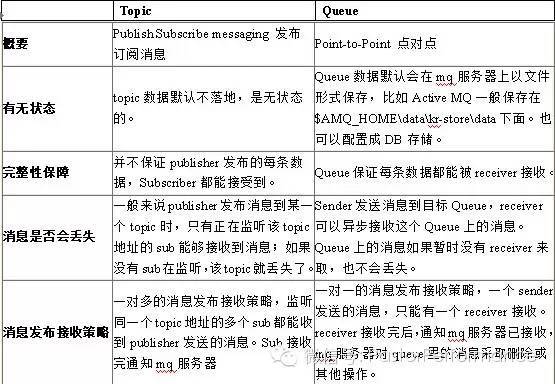- queue与topic的技术特点对比

Topic和queue的最大区别在于topic是以广播的形式,通知所有在线监听的客户端有新的消息,没有监听的客户端将收不到消息;而queue则是以点对点的形式通知多个处于监听状态的客户端中的一个。
- topic和queue方式的消息处理效率比较
通过增加监听客户端的并发数来验证,topic的消息推送,是否会因为监听客户端的并发上升而出现明显的下降,测试环境的服务器为ci环境的ActiveMQ,客户端为我的本机。
从实测的结果来看,topic方式发送的消息,发送和接收的效率,在一个订阅者和100个订阅者的前提下没有明显差异,但在500个订阅者(线程)并发的前提下,效率差异很明显(由于500线程并发的情况下,我本机的cpu占用率已高达70-90%,所以无法确认是我本机测试造成的性能瓶颈还是topic消息发送方式存在性能瓶颈,造成效率下降如此明显)。
Topic方式发送的消息与queue方式发送的消息,发送和接收的效率,在一个订阅者和100个订阅者的前提下没有明显差异,但在500个订阅者并发的前提下,topic方式的效率明显低于queue。
Queue方式发送的消息,在一个订阅者、100个订阅者和500个订阅者的前提下,发送和接收的效率没有明显变化。
Topic实测数据:
|
|
发送者发送的消息总数 |
所有订阅者接收到消息的总数 |
消息发送和接收平均耗时 |
|---|---|---|---|
|
单订阅者 |
100 |
100 |
101ms |
|
100订阅者 |
100 |
10000 |
103ms |
|
500订阅者 |
100 |
50000 |
14162ms |
Queue实测数据:
|
|
发送者发送的消息总数 |
所有订阅者接收到消息的总数 |
消息发送和接收平均耗时 |
|---|---|---|---|
|
单订阅者 |
100 |
100 |
96ms |
|
100订阅者 |
100 |
100 |
96ms |
|
500订阅者 |
100 |
100 |
100ms |
- topic方式的消息处理示例
通过客户端代码调用来发送一个topic的消息:
import javax.jms.Connection;
import javax.jms.ConnectionFactory;
import javax.jms.DeliveryMode;
import javax.jms.Destination;
import javax.jms.MessageProducer;
import javax.jms.Session;
import javax.jms.TextMessage;
import org.apache.activemq.ActiveMQConnection;
import org.apache.activemq.ActiveMQConnectionFactory;
publicclass SendTopic {
privatestaticfinalint SEND_NUMBER = 5;
publicstaticvoid sendMessage(Session session, MessageProducer producer)
throws Exception {
for ( int i = 1; i <= SEND_NUMBER; i++) {
TextMessage message = session
.createTextMessage(“ActiveMq发送的消息” + i);
//发送消息到目的地方
System. out.println(“发送消息:” + “ActiveMq 发送的消息” + i);
producer.send(message);
}
}
publicstaticvoid main(String[] args) {
// ConnectionFactory:连接工厂,JMS用它创建连接
ConnectionFactory connectionFactory;
// Connection:JMS客户端到JMS Provider的连接
Connection connection = null;
// Session:一个发送或接收消息的线程
Session session;
// Destination:消息的目的地;消息发送给谁.
Destination destination;
// MessageProducer:消息发送者
MessageProducer producer;
// TextMessage message;
//构造ConnectionFactory实例对象,此处采用ActiveMq的实现jar
connectionFactory = new ActiveMQConnectionFactory(
ActiveMQConnection. DEFAULT_USER,
ActiveMQConnection. DEFAULT_PASSWORD,
“tcp://10.20.8.198:61616”);
try {
//构造从工厂得到连接对象
connection = connectionFactory.createConnection();
//启动
connection.start();
//获取操作连接
session = connection.createSession( true, Session. AUTO_ACKNOWLEDGE);
//获取session注意参数值FirstTopic是一个服务器的topic(与queue消息的发送相比,这里是唯一的不同)
destination = session.createTopic(“FirstTopic”);
//得到消息生成者【发送者】
producer = session.createProducer(destination);
//设置不持久化,此处学习,实际根据项目决定
producer.setDeliveryMode(DeliveryMode. PERSISTENT);
//构造消息,此处写死,项目就是参数,或者方法获取
sendMessage(session, producer);
session.commit();
} catch (Exception e) {
e.printStackTrace();
} finally {
try {
if ( null != connection)
connection.close();
} catch (Throwable ignore) {
}
}
}
}
启动多个客户端监听来接收topic的消息:
publicclass ReceiveTopic implements Runnable {
private StringthreadName;
ReceiveTopic(String threadName) {
this.threadName = threadName;
}
publicvoid run() {
// ConnectionFactory:连接工厂,JMS用它创建连接
ConnectionFactory connectionFactory;
// Connection:JMS客户端到JMS Provider的连接
Connection connection = null;
// Session:一个发送或接收消息的线程
Session session;
// Destination:消息的目的地;消息发送给谁.
Destination destination;
//消费者,消息接收者
MessageConsumer consumer;
connectionFactory = new ActiveMQConnectionFactory(
ActiveMQConnection. DEFAULT_USER,
ActiveMQConnection. DEFAULT_PASSWORD,”tcp://10.20.8.198:61616″);
try {
//构造从工厂得到连接对象
connection = connectionFactory.createConnection();
//启动
connection.start();
//获取操作连接,默认自动向服务器发送接收成功的响应
session = connection.createSession( false, Session. AUTO_ACKNOWLEDGE);
//获取session注意参数值FirstTopic是一个服务器的topic
destination = session.createTopic(“FirstTopic”);
consumer = session.createConsumer(destination);
while ( true) {
//设置接收者接收消息的时间,为了便于测试,这里设定为100s
TextMessage message = (TextMessage) consumer
.receive(100 * 1000);
if ( null != message) {
System. out.println(“线程”+threadName+”收到消息:” + message.getText());
} else {
continue;
}
}
} catch (Exception e) {
e.printStackTrace();
} finally {
try {
if ( null != connection)
connection.close();
}catch (Throwable ignore) {
}
}
}
publicstaticvoid main(String[] args) {
//这里启动3个线程来监听FirstTopic的消息,与queue的方式不一样三个线程都能收到同样的消息
ReceiveTopic receive1= new ReceiveTopic(“thread1”);
ReceiveTopic receive2= new ReceiveTopic(“thread2”);
ReceiveTopic receive3= new ReceiveTopic(“thread3”);
Thread thread1= new Thread(receive1);
Thread thread2= new Thread(receive2);
Thread thread3= new Thread(receive3);
thread1.start();
thread2.start();
thread3.start();
}
}